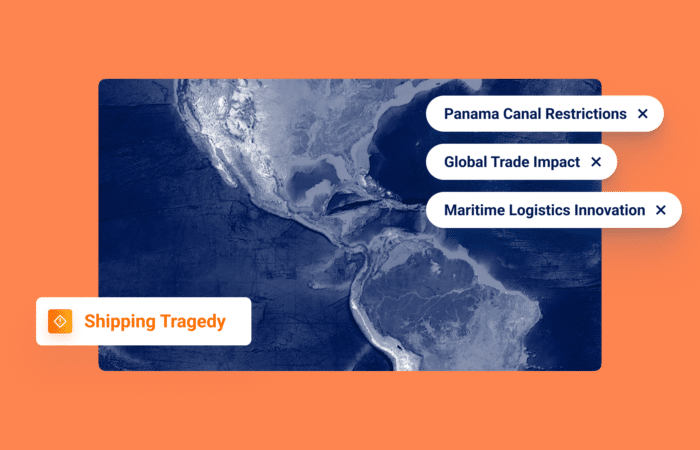What’s inside?
Without quality data, logistics and supply chain organizations cannot effectively manage container tracking or customer interactions, or make strategic decisions…but unfortunately, the maritime and ocean freight industries have data issues. The phrase, “Garbage in, garbage out” comes to mind. AIS data comes with a great deal of “noise” and effective container tracking is not just about data, it involves quick mining to produce actionable insights.
Some organizations are overly reliant on a single source for data, while others are struggling with data integrity issues:
- Location verification – is my container loaded or discharged where I expect it to be?
- Vessel identification – is the vessel reported the actual vessel that transports my cargo?
- Inaccurate reporting of milestones – did the reported event actually occur? For instance, if the container was reported as “loaded”, is it really aboard the vessel?
These data obstacles can lead to inadvertently tracking the wrong shipment or vessel. Windward conducted a data comparison and found that with an industry-standard transportation management system (TMS), logistics and supply chain organizations are tracking the wrong vessel 17% of the time!* The current state of data makes it difficult for organizations to achieve visibility, let alone actionable visibility. This situation impacts strategic decision-making, cost-savings initiatives, and the customer experience.
*One or more of the shipment legs was misaligned with Windward’s data, which is validated by vessel activity/port calls.
Substandard Standardization?
One problem fueling the data doldrums is something we like to call “substandard standardization.” Milestone tracking is critical for importers, exporters, and freight forwarders, but which milestones should be tracked? How should they be tracked?
There is no unifying standard method for milestone validation.
Additionally, a lack of standard data formats causes inconsistencies: for example, should searches be performed using the vessel name, or the IMO?
Meanwhile, an even larger standardization issue exists…
DCSA – the Future Standard
The Digital Container Shipping Association (DCSA) has a goal to make shipping services easy to use, flexible, efficient, reliable, and environmentally-friendly. It has established standards for a common technology foundation that enables global collaboration.
One of these standards is Track & Trace: “DCSA and its member carriers have published track and trace (T&T) standards for the global container shipping industry. These standards comprise a common set of processes as well as data and interface standards that can be implemented by carriers, shippers and third parties to enable cross-carrier shipment tracking. Once implemented, the standards will enable customers and supply chain participants to digitally communicate with all carriers in a unified way.”
With major industry players involved, this will be the future standard. The documentation and definitions are defined by industry specialists and software developers, ensuring they are designed for industry needs. It will be difficult to accurately track containers without adopting this standard.
Windward – Implementing a New Standard of Accuracy
Windward has implemented a new standard of accuracy in our Ocean Freight Visibility solution. To help customers overcome the data challenges described above, including the lack of standardization, we rebuilt our entire OFV data layer architecture. Windward has incorporated the DCSA’s API events, and main principles and concepts into our architecture.
Our new data draws upon multi-source data, synthesizing raw data, container data, vessel activity, and human input. This multitude of sources reduces the chances of errors and facilitates greater accuracy.
Flexible and reliable data means changes are triggered by events and don’t affect all data. Integrating multiple sources (shipping lines, but also terminals, port calls, etc.) enables avoidance of duplication, selection of the correct sources for milestone tracking, and the ability to send configurable updates for each shipment – not just when there are changes.
Incremental data validation in our rebuilt platform prevents bottlenecks and having to cope with a full load of statuses, speeding processes and removing an unnecessary anchor.
The rebuilt architecture features business intelligence (BI) and analysis capabilities – complicated analytics capabilities will be available via an event-based data structure.
Here are five customer benefits from this upgrade:
- Greater accuracy – breaking problems into different phases via flexible architecture enables the creation of accurate data sets, independent from data providers’ errors
- Latency – streaming architecture transforms each event individually, ensuring minimal latency, especially for port calls
- Flexibility – a step-by-step concept allows local changes to logic options, for quick fixes (broken into microservices. Services aren’t packaged, so you can change data)
- Data versatility – standard event structure allows transformation of different data sources and types to a single stream of data (terminal, or rail)
- Enhanced editing – architecture will empower users to manually edit events
You can’t make good decisions if you are relying on faulty data. Windward’s new data platform can help!














